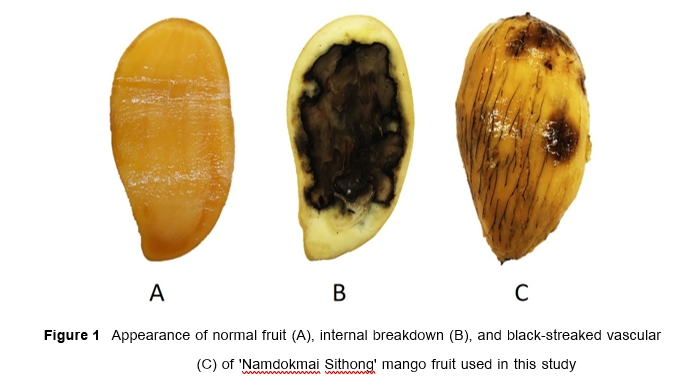Physico-chemical quality comparison of ‘Namdokmai Sithong’ mango fruit with internal breakdown and black-streaked vascular symptoms
Keywords:
Quality, internal breakdown, black-streaked vascular, Namdokmai Sithong’ mangoAbstract
Physico-chemical quality assessments of ‘Namdokmai Sithong’ mango fruit with internal breakdown and black-streaked vascular symptoms were conducted using a completely randomized design (CRD) with 5 treatments: normal pulp of intact fruit, normal pulp of internal breakdown fruit, internal breakdown pulp (IB), normal pulp of black-streaked vascular fruit, and pulp containing black-streaked vascular (BSV) symptom. The results indicated that the pulp of normal fruit and normal pulp of internal breakdown fruit had the lowest percentage of dry weight. In the case of total titratable acidity, black-streaked vascular pulp had the lowest amount, whilst the highest value was found in normal pulp of internal breakdown fruit. For instance, internal breakdown pulp had the lowest value of total soluble solids, while it had the greatest amount of phenolic compound content. Nonetheless, vitamin C and carotenoid contents of mango pulp from all treatments were not statistically different. Lastly, when performing principal component analysis using 6 quality parameters, it was found that, PC1 and PC2 could adequately explain quality variations of mango pulp, achieving 45.42%.
References
Tharanathan RN, Yashoda HM, Prabha TN. Mango (Mangifera indica L.), "The king of fruits"-an overview. Food Rev Int. 2006; 22: 95-123.
Shivashankar S. Physiological disorders of mango fruit. Hortic Rev. 2014; 42: 313-347.
Poovarodom S. Calcium and boron fertilizer. In: Rudanachaless T, Kumpoun W, Jaroenkit T,. Mango production and postharvest technology, 1st ed. Bangkok: Postharvest Technology Innovation Center, Ministry of Higher Education; 2013. p. 239-246.
Shreedevasena S, Sankar PM. Resin canal discolouration (RCD) – A great handling disorder in mango (Mangifera indica L.). Biotica. 2020; 2(6): 405-406.
Ma X, Yao Q, Ma H, Wu H, Zhou Y, Wang S. Relationship between internal breakdown and mineral nutrition in the flesh of 'Keitt' mango. Acta Hortic. 2018; 1217: 351-356.
Raymond L, Schaffer B, Brecht JK, Crane JH. Internal breakdown in mango fruit: symptomology and histology of jelly seed, soft nose and stem-end cavity. Postharvest Biol Technol. 1998; 13: 59-70.
AOAC. Official Methods of Analysis: Association of Official Analytical Chemists, 17th ed. Washington, DC: AOAC International; 2000. 4377 p.
Ranganna S. Handbook of Analysis and Quality Control for Fruit and Vegetable Product, 2nd ed. New Delhi: Tata McGraw-Hill Publishing Company Limited; 1986. 1111 p.
Rumainum IM, Worarad K, Srilaong V, Yamane K. Fruit quality and antioxidant capacity of six Thai mango cultivars. Agric Nat Resour. 2018; 15: 1-7.
Boonyakiat D. Plant physiology, 1st ed. Chiang Mai: Faculty of Agriculture, Chiang Mai University; 2020. 292 p.
Raymond L, Schaffer B, Brecht JK, Hanlon EA. Internal breakdown, mineral element concentration, and weight of mango fruit. J Plant Nutr. 1998; 21(5): 871-889.
Bernardes SAP, Nascimento JRO, Lajolo FM, Cordenunsi BR. Starch mobilization and sucrose accumulation in the pulp of Keitt mangoes during postharvest ripening. J Food Biochem. 2008; 32: 384-395.
Shashirekha MS, Patwardhan MV. Changes in amino acids, sugars and nonvolatile organic acids in a ripening mango fruit (Mangifera indica, Badami variety). Lebensm Wiss Technol. 1976; 9: 369-370.
Sarker S, Muhsi AA. A study on the content and interconversions of organic acids of mango (Mangifera indica L.) at various stages of fruit development. Bangladesh J Agricult Res. 1981; 8: 69-75.
Medlicott AP, Thompson AK. Analysis of sugar and organic acids in ripening mango fruit (Mangifera indica var. Keitt) by high performance liquid chromatography. J Sci Food Agric. 1985; 36: 561-566.
Lima LCO, Chitarra AB, Chitarra MIF. Enzymatic activity changes in spongy tissue: a physiological ripening disorder of ‘Tommy Atkins’ mango. Acta Hortic. 1999; 485: 255-258.
Burdon M, Moore KG, Wainwright H. Mineral distribution in mango fruit susceptible to the physiological disorder soft nose. Sci Hortic. 1991; 48: 329-336.
Chitarra MIF, Chitarra AB, Lima LC. Internal breakdown in mango fruit: changes in cell wall compounds. Acta Hortic. 1999; 485: 91-96.
Siriphanich J. Postharvest biology and plant senescence, Nakhon Pathom: Kasetsart University Kamphaeng Saen Campus; 2006. 453 p.
Mitra SK. Postharvest Physiology and Storage of Tropical and Subtropical Fruits. Oxfordshire, UK: CAB International; 1997. 431 p.
Nath P, Bouzayen M, Matto AK, Pech JC. Fruit Ripening Physiology, Signalling and Genomics. Croydon, UK: CPI Group (UK) Ltd; 2014. 674 p.
Ketnark K. Moisture content determination of arabica green coffee by near infrared spectroscopy, Chiang Mai: Chiang Mai University; 2556. 106 p.

Downloads
Published
How to Cite
Issue
Section
License
Copyright (c) 2022 Naresuan Phayao Journal

This work is licensed under a Creative Commons Attribution-NonCommercial-NoDerivatives 4.0 International License.
ผู้นิพนธ์ต้องรับผิดชอบข้อความในบทนิพนธ์ของตน มหาวิทยาลัยพะเยาไม่จำเป็นต้องเห็นด้วยกับบทความที่ตีพิมพ์เสมอไป ผู้สนใจสามารถคัดลอก และนำไปใช้ได้ แต่จะต้องขออนุมัติเจ้าของ และได้รับการอนุมัติเป็นลายลักษณ์อักษรก่อน พร้อมกับมีการอ้างอิงและกล่าวคำขอบคุณให้ถูกต้องด้วย
The authors are themselves responsible for their contents. Signed articles may not always reflect the opinion of University of Phayao. The articles can be reproduced and reprinted, provided that permission is given by the authors and acknowledgement must be given.







